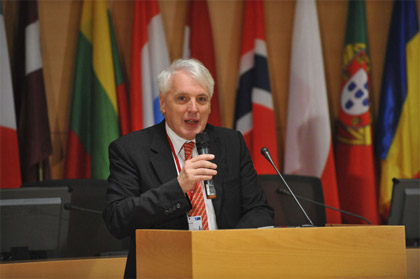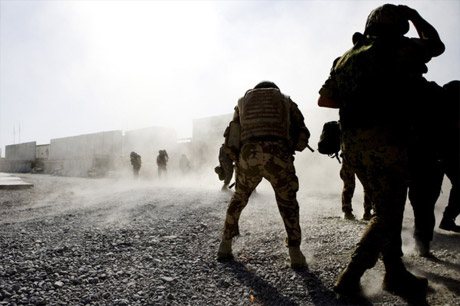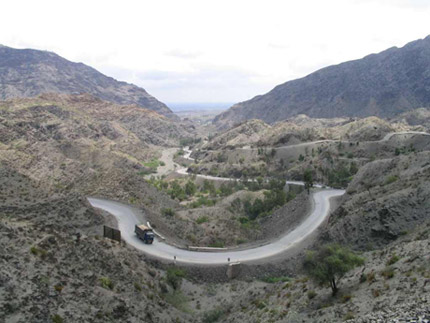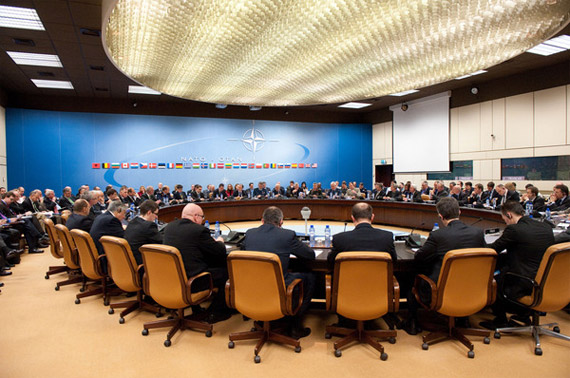Environmental Change & Emerging Threats
According to Jamie Shea, Deputy Assistant Secretary General for Emerging Security Challenges, NATO looks at environmental change very carefully because of its increasing impact on security. The International Panel on Climate Change’s (IPCC) latest report is clear that, according to Shea, “within 10 to 20 years, we are going to see important impacts in many areas, which will have an effect on security. For instance, changes in rainfall with increasing droughts will impact agricultural production. Growing ocean acidification will have consequences for plant life, fauna and fish stocks. These changes could, in turn, lead to human migratory flows, which are already severe in some parts of the world. Security problems and disputes could occur over the sharing of arable land and water resources, such as important rivers. Think, for instance, of the role Africa’s Nile River plays in sustaining countries economically. And, consider freak weather conditions. We have already seen how Hurricane Katrina led to the deployment of 30,000 U.S. troops to deal with levee issues, evacuations, looting and public order in a situation where local authorities and emergency rescue services were overwhelmed by the extent of the disaster.
“Whether or not one attributes events like Hurricane Katrina to global warming, the evidence increasingly shows that we are seeing more and more freak weather conditions. We have had flooding in Europe not seen for centuries. And two years ago heat waves in Russia were causing Russians to dive into Moscow fountains in their suits in the middle of summer. This is not something people normally expect to happen. Again, the military in a number of countries has dealt with flooding and forest fires as a consequence of very high temperatures. High temperatures also mean increased disease vectors, such as migratory insects – mosquitoes, for example – that follow the heat wave. This increases the possibility of epidemics coming back.
“One doesn’t want to be a ‘Cassandra’ or paint too alarmist a picture, but many military establishments, particularly in the Pentagon but also in Europe, are starting to seriously factor in climate change. The latter also has consequences for the resiliency of critical infrastructure. For example, if permafrost starts to melt then railway lines inside Siberia, as well as energy and oil pipelines, can be affected. How do countries make critical infrastructure more resilient to extreme weather conditions? This is definitely now a topic for the military and a topic for NATO.”
To address environmental issues threatening security in vulnerable regions, NATO joined five other international agencies in 2004 to form the Environmental and Security (ENVSEC) Initiative. The five other agencies include: the United Nations Development Programme (UNDP), United Nations

© NATO|Jamie Shea gives the introduction at the Strategic
Concept Seminar 1: NATO’s Fundamental Security Tasks.
Environmental Programme (UNEP), Organization for Security and Cooperation in Europe (OSCE), United Nations Economic Commission for Europe (UNECE) and Regional Environment Center for Central and Eastern Europe (REC). “As a result, NATO is able to factor in, in terms of its policy planning and strategic assessments, the best science on climate change and start to model scenarios the military may have to deal with,” explains Shea.
The Deputy Assistant Secretary General also comments that “this also has consequences for procurement. For instance, more flat-bottomed vessels, patrol boats or helicopters may be necessary when dealing with floods. Such situations may also require soldiers trained to respond to riot situations. Therefore, environmental change produces consequences for the equipment militaries purchase and the way they train their forces as well.
The Question of Libya
“When the NATO air campaign finished at the end of the September/October timeframe, the Libyan authorities – the new government – did not ask us to undertake any on-the-ground follow-on mission. So, for the time being, NATO doesn’t have an activity in Libya. We have offered the Libyans help in a number of areas, which includes tracking weapons that may have gone missing, like MANPADS. (MANPADS or MPADS are “Man-portable” air-defense systems, which are shoulder-launched surface-to-air missiles – SAMS – that present a threat to low-flying aircraft.) They are a very big concern. We have seen in Afghanistan the huge impact these weapons can have if they fall into the wrong hands. Missiles in the hands of terrorist organizations could have severe implications with respect to commercial air traffic.
“Securing stocks of Libya’s chemical weapons, which unfortunately still exist notwithstanding Kadafi’s pledge to have destroyed them, is also of concern. Another concern is the Libyans’ need to transform hundreds of militias and armed groups that, at the moment, do not seem willing to give up their weapons even though Kadafi is gone. The goal is to transform these groups into a Libyan Army and Libyan Police service so the State, once again, has a monopoly on the use of force, which is the definition of a proper State. Much work is necessary and NATO is well-experienced in this area from the transformation of communist societies after 1989 to our work in Afghanistan and the Balkans on what is called, ‘Security Sector Reform.’ But, obviously, NATO cannot impose changes on the Libyans. They have to ask for it. The offer is on the table. Once Libya starts to form a proper government and sets-up its ministry of defense, my own belief – this is a personal view – is that they will come to us and ask for aid and assistance.”
Shea explains that NATO and the United States go together like husband and wife in the sense that they are not dissociable. He comments: “NATO would not be NATO without the United States. Without the enormous military capabilities the U.S. provided to NATO’s Unified Protector Mission that mission would not have been successful or would have taken longer to be successful. It is crystal clear that the U.S. played a very significant role in the demise of the terrible Kadafi regime and the prospect Libya has now to become a proper democracy at the service of its citizens. The Libyan people are grateful to the United States, not just to NATO or NATO Europe.
“When U.S. Secretary of State Hilary Clinton went to Tripoli, she was received as positively as England’s David Cameron and France’s Nicolas Sarkozy. The Obama Administration dealt with the Libya situation in a sensible way by making sure the Europeans had a major role in the operation.

© NATO|Schools in Tripoli, Libya open their doors.
It was not seen in that part of the world as a U.S. operation or a NATO operation in disguise for the U.S. The way the mission was conducted means that NATO’s image in the Arab world – not just in Libya but throughout the Arab world – has improved. This is particularly true given that Qatar, the United Arab Emirates, Jordan and Morocco also participated in the NATO operation. We had Arab countries that actually participated militarily in the NATO operation, which is an absolute first for that degree of Arab involvement. And, secondly, we had the support of the Arab League.”
The NATO framework is a multi-national one involving 28 countries with legitimacy precisely because so many countries are involved – many of which have strong historic links to the region, such as France, Italy and Greece. Shea believes it is a “tried and tested framework because NATO has run these training programs in conjunction with its ‘Mediterranean Dialogue,’ which has existed since 1994. Libya is not a member of this yet, but I believe NATO will invite a democratically elected Libyan government to join the Dialogue in the future. The Mediterranean Dialogue brings together seven countries of the region to work with NATO on a host of problems dealing with military reform and military restructuring. It is a recognized entity in that region of the world in terms of type of training and cooperation it offers.
NATO Training Impacts
“NATO deals with many partner countries that are more in the front line of climate change than some of its European countries. Everyone is going to be affected by climate change, but it is obvious that some countries are more immediately concerned than others. Afghanistan, for example, has been experiencing a severe drought for several years now. Three million Afghans are suffering from undernourishment as a consequence of the drought’s affect on wheat growth agriculture. Secondly, another consequence is farmers growing poppy for heroine not only because it is a money-making crop but also because poppy does not require much water. And, it is easy to store. It is a better crop for an environmentally stressed country than corn or maize, for instance. The above are examples of how environmental factors can have an impact on NATO missions. Therefore, one of the issues we need to work on is how the military can assist with things like irrigation and drainage ditches. Many of Afghanistan’s irrigation canals have been destroyed by 20 years of war.”
Shea makes it clear that military operations must factor in the civil side. He explains that military engineers can build roads, repair irrigation ditches and canals, get communications up and running and restore power. NATO’s International Security Assistance Forces (ISAF) restarted Afghanistan’s Kajaki Dam, which is a hydroelectric power system in the south that was in disrepair for years due to war. The military actually transported turbines in order to repair the system, which means Kandahar now enjoys electricity for civil projects and irrigation. (Read livebetter’s July/August 2011 lead article entitled, “U.S. Army Corps of Engineers: Sustainable Development in Afghanistan”).

Source: Liepke Plancke, AVDD, RNLAF|The NATO Military Committee visits Kandahar, Afghanistan.
The Deputy Assistant Secretary General maintains that “a growing link exists between success of a military operation and ability to deal with stresses caused by environment. NATO can train local forces in these type skills because we know armies are not just for fighting. However, when training armies elsewhere, other countries often believe the only role of the army is to fight because they have a more limited or restricted view. But, the role of the armed forces is to protect the population in the wider sense. NATO can definitely petition to pass on this service role ideology. Pre-deployment training about these type issues is vital so the force can hit the ground running; this is extremely important.
“NATO has been in Afghanistan since 2003 in an environmentally stressed country with a rapidly growing population but also with drought, water shortages, difficulties in agricultural production and lack of infrastructure. The country has minds to exploit if it could get infrastructure into a business model and investments to start that out. As a consequence, much of NATO’s effort is involved in the provincial reconstruction teams (PRT), which it runs to assist with development, education, agricultural projects, telecommunications and infrastructure. (For more information on PRTs read the U.S. Agency for International Development’s 2006 Provincial Reconstruction Teams in Afghanistan: An Interagency Assessment.) A percentage of NATO forces are involved in combat operations, particularly Special Forces in the south and east of Afghanistan. But, the bulk of NATO missions are involved in civil reconstruction, training-type operations. Both need to be done simultaneously to be successful.”
Military Force & Green Considerations
Although environmental effects occur as a direct result of using military force, Shea argues that these problems are decreasing. According to Shea: “Modern technology allows for a higher impact with less use of force. The Libyan air campaign, because of its enormous accuracy with precision-guided munitions, only needed one-quarter of the flight missions required in 1999 in Kosovo to bring about a similar result. In other words, NATO did not need to fly so many planes, which saved millions of liters of kerosene. In World War II, Allies had to fly 120 Flying Fortresses, or Lancaster bombers, to hit the target. They needed to drop an enormous number of bombs to be certain one of them would randomly hit the target, and one-half million German civilians died in those bombing campaigns. Compare that with today’s drones that don’t use any kerosene but which have incredible intelligence and accuracy on-target.
“Another example is modern aircraft with precision-guided munitions. The United Nations did a report on NATO’s operations in Tripoli saying that virtually no buildings were destroyed; it was an extremely accurate campaign. Modern technology (robotics, artificial intelligence, smart munitions), because of its increased accuracy, means less military force, which means reduced carbon footprint in terms of CO2 and reduced overall destruction to the environment. Consistent with this mentality is the need for more fuel-efficient vehicles, which is very important for NATO forces. Because all our armies need to reduce their budgets, finding more efficient ways of operating is increasingly important.
“NATO has a research and technology organization with scientists and industry that looks into environmental considerations, such as green weaponry, carbon emissions and fuel efficiency. They try to set standards while sharing technology and know-how. There is an economic rationale to save money by having green technology, but it also gives NATO more operational independence and flexibility compared to traditional fuel.

© James Mollison|Khyber Pass, Pakistan
Dependence on oil and kerosene creates a terrible logistics problem, as evidenced by current difficulties in Pakistan’s Khyber Pass.
“During the Second World War, the German Luftwaffe was not shot out of the skies; it was grounded because the Germans ran out of petrol. They had jet aircraft, which could have caused terrible problems for the Allied Forces, but, fortunately, by the time they developed these planes they had run out of petrol. The Germans were producing artificial petroleum at the end of the war but not enough, so their planes were grounded, which gave the Allies a decided advantage. That is an example of the criticality of oil in warfare and one reason why reducing dependency on foreign supplies and on large consumption is necessary. I agree it is good for the environment, but it is also good for economic and efficiency reasons as well.
“With respect to increasing use of electronics – drones, robots and artificial intelligence – an expert pointed out to me that for the price of one F-35/Joint Strike Fighter, the United States could procure 80 Global Hawk drones (unmanned aerial vehicles). Another expert pointed out that for every pilot the U.S. trains to fly a plane, it is training four or five pilots to operate drones thousands of miles away from where those drones are actually being deployed.”
Shea says that a military increasingly dependent upon electronics, which uses batteries more than oil, will increasingly require rare earth metals, such as lithium. He explains that China produces about 90 percent of the world’s rare earth metals. “One thing NATO is looking at is an industrial strategy whereby we produce these materials ourselves. Otherwise, we have just replaced one foreign dependency with another. China is not producing 90 percent of rare earths because it has 90 percent of the deposits. Canada and other countries have large amounts, but, because of cost and need, these resources have not been developed,” comments Shea.
Four Critical Threats
NATO talks about threats as “emerging” when they are, according to Shea, in reality “evolving.” He explains that “‘emerging’ suggests NATO is just discovering them, but one of the challenges – proliferation of ballistic missiles – has been around for awhile. Number one is cyber because it is growing exponentially and citizens and organizations – banks, insurance companies and government institutions – are increasingly aware of how easy it is for secrets, intellectual property, credit card identities and money from ATM machines to be stolen. Given the world’s increasing dependency on the internet, which will move from computers to mobile phones within the next few years, more time is spent in the virtual world. It is vital to make cyberspace a more secure area and make it harder for hackers to penetrate defense systems. This is going to be a major problem.
“The second problem is critical infrastructure. It is imperative to ensure that if a major cyber attack occurs – a major energy cut-off, storm or disaster – that critical infrastructure, such as smart grids, pipelines, power station controls, air and road traffic control systems, is resilient. That means redundancy by means of standby and/or replacement so the affected structure goes back online quickly. Nations must be more resilient to shocks that can occur to critical infrastructure and assess their vulnerability.

© iStockphoto.com/deepblue4you
Where are systems vulnerable; where are choke points; where are interfaces that could attract terrorists or lead to catastrophic systems failure? For example, in Europe during the summer of 2007 a power transmitter in Italy broke down and plunged one-third of Switzerland into darkness for several hours because of cross-border electrical system integration. This shows that a person can be vulnerable to even a small incident taking place in another country. Britain, for instance, now obtains much of its electricity from France through its nuclear power. Germany has decided to stop nuclear power, but it will now also rely on imported nuclear energy from other countries. As nations obtain more of their energy from other countries, grids become increasingly interlinked. Therefore, it is important to make them resilient and to have alternatives in case of failure.
“The third issue is terrorism. Yes, Bin Laden is dead, and al-Qaeda Central is a shadow of its former self. But, terrorism is going to continue because it is a very asymmetric type of threat. It is very easy for terrorists to wreak havoc even with small groups. Even failed attacks can paralyze an airport for days and cause chaos for thousands of passengers. The al-Qaeda franchise still exists in Yemen, the Maghreb and elsewhere. Intelligence cooperation is still necessary to provide early warning.
“The phenomenon of the individual who radicalizes himself/herself on the internet without going to a terrorist training camp is also an ongoing concern. How do we look at de-radicalization – becoming aware of individuals going to the ‘dark side’ so we can try to de-radicalize them before they cross the rubicon and become irreversible terrorists? And, of course, if terrorist organizations obtain nuclear, chemical or biological weapons then particularly severe kinds of attacks are possible. So, it is vital to keep that under control.
“The final item is ballistic missile proliferation. Thirty states have them with Iran developing more capable ones every day. Remember how the world changed after 9/11, which was an attack using box cutters and a conventional aircraft. Think of how the world would change if a ballistic missile hit an American or European city tomorrow. It would be massive. NATO is involved in missile defense and strongly supports programs to strengthen arms control regimes to make it harder for countries to obtain materials necessary to make ballistic missiles.”
According to Shea, a host of other threats exist, such as epidemics, pandemics and organized crime, but NATO cannot do everything. It doesn’t have the mandate or the capabilities, so it is focusing on those four things. Shea maintains the bottom line is that “NATO’ s role is to defend its populations against threats to their security. As those threats evolve and become more diverse, so NATO has to become a more versatile and capable organization. These days threats not only come in the form of tanks, bomber aircraft or nuclear missiles. They also come through the internet, through fiber optic cables and through lone individuals driving car bombs into cities. NATO, to remain relevant in the 21st Century, must find answers to these new threats as well as more familiar and traditional ones.”

© NATO|A NATO meeting of cyber defense experts.
Jamie Shea holds a D.Phil in Modern History from Oxford University and speaks French, Dutch, German, Spanish and Italian, in addition to his native English. His current external academic positions include: Professor, Collège d’Europe, Bruges; Lecturer, Brussels School of International Studies, University of Kent; Associate Professor of International Relations, American University, Washington, D.C.; External Advisor, Post-graduate curriculum development, University of Sussex; Chair of Transatlantic Programme, Royal Holloway College, University of London.
Shea is a regular lecturer and conference speaker on NATO and European security affairs and on public diplomacy and political communication and lobbying. He is also an external examiner, candidates for Ph.D. degree, London School of Economics, University of St Andrews, Department of War Studies, King’s College, University of London, University of Kent, Canterbury and University of Iceland. Shea is a Member of the Advisory Board, Security and Defence Programmes, Chatham House; Member of the Policy Council, World Economic Forum, Geneva; Founder and Member of Board, Security and Defence Agenda, Brussels and Member of the Advisory Board, Centre d’Etudes et de Prospectives Stratégiques, Paris.




























